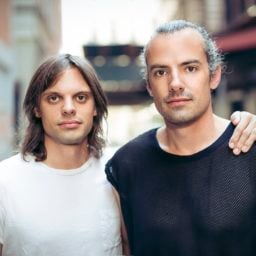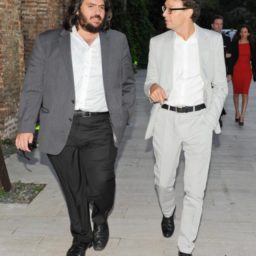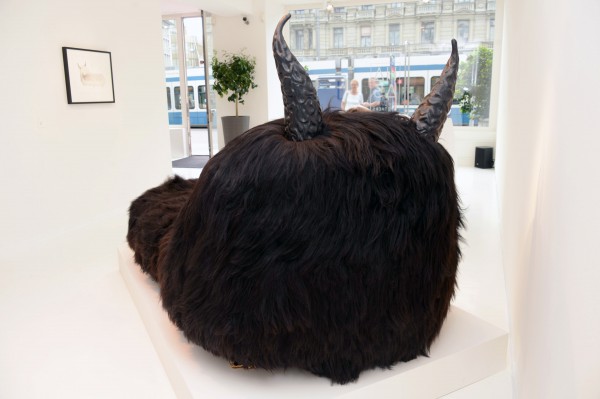

It’s been a wild year for Simon and Nicolai Haas, better known as The Haas Brothers. In the midst of a knock-0ut presentation at last year’s Design Miami/Basel, they were introduced to Galerie Gmurzynska director Isabelle Bscher through a mutual friend, actor/artist Vincent Gallo. That led to their current show, Feinstein, at the gallery through the end of the end of July. Meanwhile, the brothers have worked on collaborations with Versace and gained serious clout as both artists and designers. artnet News caught up with the duo to hear about their return to family roots, and normalizing double penetration through art.
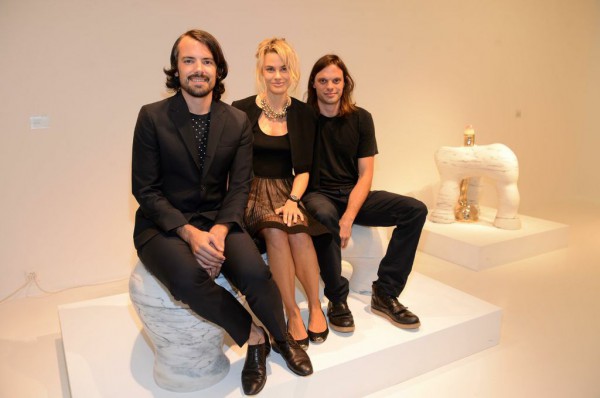
From left: Simon Haas, Isabelle Bscher, Nikolai Haas.
Photo: Courtesy Galerie Gmurzynska.
How have things been progressing over the past year?
Simon Haas: We have had a real creative explosion, honing in on what it is we do and what it is we want—the presentation in Zurich is our most ambitious and refined yet. We are beyond excited.
Nikolai Haas: The main difference is that we are becoming much better at speaking to an audience through our work. Our work is rapidly becoming more conceptual and philosophical. Also this is our first collection of stone. Most of these pieces are pretty large scale compared to what we showed in Basel last year. In fact, they are some of the largest pieces we have produced.
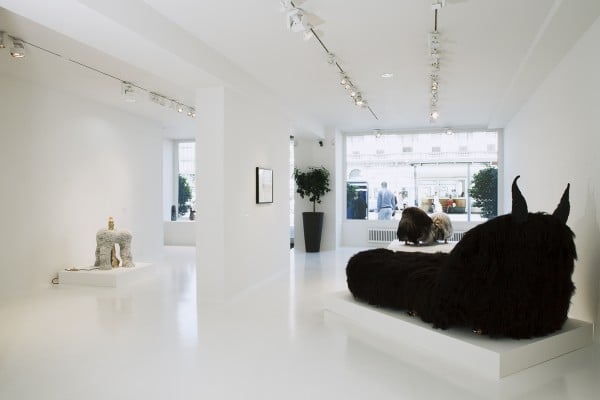
Installation view, The Haas Brothers, Galerie Gmurzynska Zürich.
Photo: Courtesy Galerie Gmurzynska.
Your practice is most often placed in the design category, but many of the works, though functional, have a strong sculptural component. How to you negotiate that line between the disciplines?
NH: Honestly, there isn’t much negotiation on our end. We express ourselves in many different mediums and venues, [but] the place that we come from is always the same. We really try to put our intention and humanity in every piece of work we make. Whether we are making furniture, sculptural work, paintings, video, or music it’s all about focusing on the end result and keeping your mind clear. The categorization comes mainly from the market and the press . . . I suppose to make it easier to pitch or organize for them. So [they] really do the negotiation of that line for us. The art world has really only known about us for a little over a year. I think it would be premature for anyone to categorize our work. We’ve only just gotten started.
SH: The truth is, we don’t see ourselves as designers. We call ourselves studio artists because the only formal consistency in our work is that it is produced by us in an insular environment. Our ambitions and artistic aspirations are coming from the same place whether we make an object called a chair or an object called a sculpture. The reason we use furniture as a vehicle is that we want our artwork to be lived with. We want the people who own our works to develop relationships with the pieces, like a pet.

Installation view, The Haas Brothers, Galerie Gmurzynska Zürich.
Photo: Courtesy Galerie Gmurzynska.
What was the main focus for you guys in this particular exhibition?
SH: The theme for this show is a return to our roots with stone carving. Our dad is a sculptor from Germany and he taught us to carve stone. Zurich is really close to where he grew up, so in a sense this is dedicated to our personal history.
NH: We grew up as stone carvers. It’s been a long time since we’ve revisited it as a medium. There are definite themes of sexuality, anthropomorphia, and psychedelia. We are really trying to get across a feeling of movement, fleshiness, and sexual action in stone. It’s difficult. Stone is heavy and unmoving, hopefully the viewer feels as if they are among ancient beasts that have been frozen in the middle of having sex or just strolling around. A lot of what we are going for is to inspire empathy for these objects—a feeling as if they are real—that they have a life force.
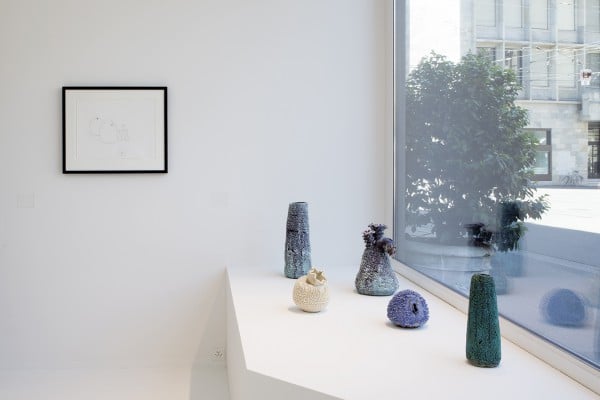
Installation view, The Haas Brothers, Galerie Gmurzynska Zürich.
Photo: Courtesy Galerie Gmurzynska.
Simon, having started out as a painter, and Nikolai, as a musician, how do those backgrounds affect your current practice?
NH: Music taught me to be expressive. I think that music is really easy to compare to language. A guitar player playing a kickass improvised solo on stage is, in a real way, speaking to an audience. In a way that’s deeper than explicit and literal verbal communication. I used to play on stage, basically naked, playing only improvised composition. This helps my nerves now, it helps me not worry about laying it all out there and it keeps me from inhibiting my thoughts.
SH: Painting has affected everything about my life. Learning to focus on something, try to understand it, hold that in your head and then replicate it is incredibly useful. I think painting has made me an expert at observing. There is also a hypnotic focus state that anyone can work themselves into—painting requires this hypnosis.
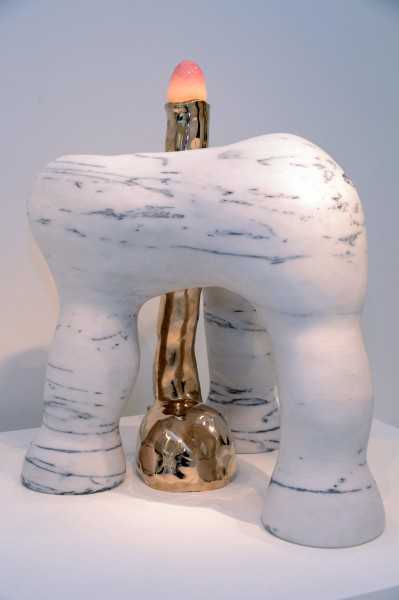
Installation view, The Haas Brothers, Galerie Gmurzynska Zürich.
Photo: Courtesy Galerie Gmurzynska.
Do you have a favorite piece in particular from the Gmurzynska show?
NH: I really like Double Penetration. Mainly because it is made of stone, cast bronze, and hand blown glass—all very beautiful materials and really great in combination. I also really like the fact that it took enormous amounts of time, money, and effort to produce and is basically depicting a super lewd sex act. Really the idea here is that it diffuses any negative connotation with DP. It brings an act that is generally shamed by society onto a stage that is intellectual and analytical. It brings the idea of sexual shame to the table. And I think that the general consensus, among the audience I expect to be attending, will be that DP is cool. There’s nothing wrong with it. It’ll work people’s heads into a place of no judgment.
SH: I love a piece call Augustus Gloop’s Golden Ticket. It’s our largest hex-tiled piece yet and it has very curly-wavy edges, which is both the most challenging and the most beautiful kind of form to tile.


